Chesapeake Bay Lighthouse Project
Southern Bay Lights
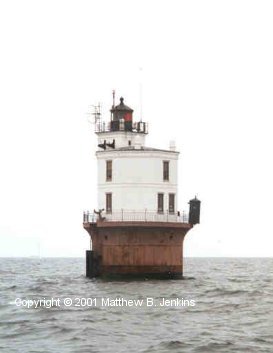
Smith Point Light
Southern Entrance to the Potomac River, VA
cir. 1897
This is the fifth lighthouse built at Smith Point at the entrance to the Potomac.
A shore-based tower had been built as early as 1802. However, its location made
it ineffectual and both storms and erosion forced it to be moved and rebuilt twice
before being abandoned. A number of light ships have been stationed there
over the years, including after 1893 when an earlier, 1868 vintage, screwpile
was destroyed by ice. The current, octagonal structure was built on a caisson
from the same plans used by Wolf Trap lighthouse. It was commissioned in 1897.
In the early 1970s the lighthouse was electrified via a sub-aquatic cable and
fully automated. Later, when the cables failed, the Coast Guard considered
demolition of the light. However, public outcry was strong and in 1988 the
cable was replaced. The light has been recently renovated and is in relatively
good condition. It is still an active aid to navigation.

Wolf Trap Light
Off Wolf Trap Spit, south of the Rappahannock River, VA
cir. 1894
This location apparently gained its name when Her Majesties 350 ton ship Wolfe
ran aground on the shoals there in 1691. Beginning in 1821 light ships were
stationed at the shoals and these, in turn, were replaced by a screw-pile lighthouse
in 1870. That lighthouse was destroyed by ice in 1893. The current structure
was built the following year and the fourth order lens, visible 11 miles, was
lit in September 1894. The lighthouse gained its distinctive red
coat of paint in either the late 1920s or early 30s. Since it was used as
a radio calibration station, it remained manned until 1971, which in part accounts
for its excellent condition. The light is still active.
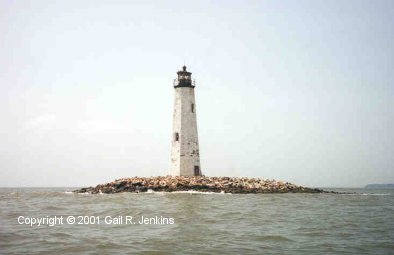
New Point Comfort Light
Northern Entrance of Mobjack Bay, VA
cir. 1804
Commissioned in 1804 to mark the north side of Mobjack Bay and the York River,
this is the third oldest lighthouse on the Bay, Despite it's name, it has no
relation to the Old Point Comfort light apart from the fact that both were built
by Elzy Burroughs (who later served as keeper here). The octagonal whitewashed
sandstone tower stands 58 feet tall and the fourth order Fresnel lens, installed
in 1865, gave it a visibility of 13 miles. The light was partially automated
in 1919 and the keepers house was torn down at that time. It was completely
automated in 1930. In 1933 a hurricane swept away the peninsula's link to the
mainland leaving the light on its current small rocky island, accessible only
by small boat. An offshore light took over the tower's duties in 1963 and in
1968 the Coast Guard discontinued maintenance. It is now owned by Mathews County
and has undergone several renovations. Vandalism continues to be a problem.
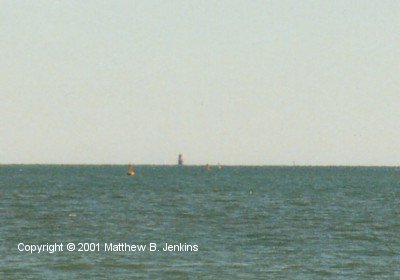
Thimble Shoals Light
Hampton Roads, VA
cir. 1914
Thimble Shoals is the name of two bars bordering the channel into Hampton Roads, VA.
In the early 1800s a lightship was used to mark this important commercial channel.
It was replaced in 1872 by a srewpile lighthouse reinforced to withstand the ice
and conditions of this particularly exposed location. This first lighthouse, was
destroyed by fire in 1880. The screwpiles were found to be intact, so a new house
was transported from Lazaretto Depot and the light was back in commission 3 months
later. However, this light seemed jinxed. In 1891 it was rammed by a
steamer, in 1898 again by a coal barge, then in 1909 a schooner in tow broke free,
and repeatedly rammed the light badly damaging the pilings, smashing the cottage,
and upsetting a wood stove that burned the structure to the water.
A much more sturdy caisson design was decided upon for the replacement light which was
completed in 1914 not far from the location of the earlier, ill-fated screwpile. At
least two workers died during its construction. This three-story cast iron tower
stands 55 feet above the water and is one of only two caisson lights on the Bay that
still have their first gallery roof. The light was automated in 1964.
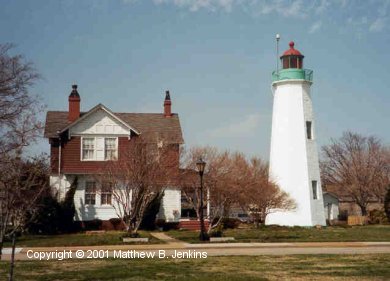
Old Point Comfort Light
Fort Monroe - Hampton, VA
cir. 1802
Old Point Comfort is the second oldest lighthouse on the Chesapeake Bay. It was
commissioned in 1802 and stands directly in front of Fort Monroe at the entrance
to Hampton Roads. During the War of 1812, the 54 foot light was captured by the British
and used as an observation tower. The light originally was lit by 11 Lewis oil lanterns.
These were later replaced by a fourth order Fresnel lens. The keepers dwelling
was replaced in 1891 and it is now used for military housing. Like several other
Bay-side towns, this area was a popular tourist destination. Due to both the
continued military and tourist presence, the light has been well maintained all
of its years. It was not automated until 1973 and until that time had two keepers.
It is still an active navigational aid and is the longest serving lighthouse on the
Chesapeake Bay.
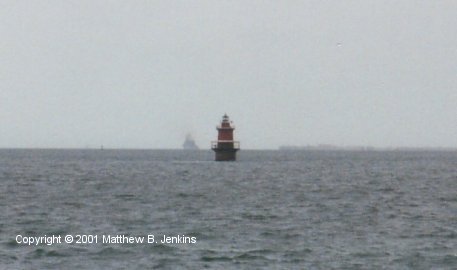
Newport News Middle Ground Light
Newport News, VA
cir. 1891
This caisson light was commissioned in 1891 to mark the Middle Ground shoal
in one of the busiest shipping channels of the Bay. The caisson and tower
stand approximately 45 feet above the water. The light was automated in 1954 and
is still active.
In addition to the nearby Navy base, commercial ports, shipyards, and
drydocks, this location is also famous for first battle between two iron-clad
warships, the U.S.S. Monitor and C.S.S. Virginia (a.k.a. Merrimack)
during the American Cival War.

Old Cape Henry Light
Cape Henry - Fort Story, VA
cir. 1792
Old Cape Henry light was built in 1792 by John McComb, Jr. and is the oldest
lighthouse on the Bay. It is the third oldest lighthouse in the United
States but the first constructed by the new colonial government. George
Washington took a personal interest in its construction and paersonally
appointed the first keeper. Sitting at
the mouth of the Chesapeake, just above Virginia Beach, the light guided
ships entering the Bay for almost 90 years. The octagonal sandstone tower is
92 feet high and sits atop a 56 foot dune. The copper dome of its lantern
is unique amongst Bay lights. It was originally accompanied
by a 2 story keepers house and an underground oil vault. A new keepers
dwelling was constructed in 1835 and over the years the lighting apparatus
changed to 18 lights and reflectors in 1841 and a second order Fresnel lens in
1857. A fog bell tower was also added in 1855. Confederate sympathizers
temporarily put the light out of commission during the early years of the Civil
War. However it was repaired and put back in operation under Union guard
in 1863. In the 1870s cracks were discovered at the tower's base on six of
the eight walls. It was deemed unsafe and in 1878 an appropriation was granted
for construction of a new tower a few hundred yards away (the New Cape Henry
Light) which was completed in 1881. Despite the dire predictions, the old tower
has held firm over the ensuing 100+ years and it is now open to the public.

New Cape Henry Light
Cape Henry - Fort Story, VA
cir. 1881
The New Cape Henry Light was completed in 1881 after numerous construction
difficulties from problems landing materials to delays in delivery of the iron
work. On December 14th, the light was taken from the Old Cape Henry
tower and displayed in the first order lens of the new structure giving it
a visible range of 18 3/4 nautical miles. The new tower stands 170 feet tall
from base to tip and is considered one of the most important of the U.S.
Atlantic coast lighthouses. Its alternating black and white paint pattern
also makes it quite distinctive. In 1984 the light was changed to un-manned
operation and soon afterwards the Coast Guard began to look at options for a
less costly beacon. A steel tower was proposed along with demolition of the
existing light. Luckily the Fifth District Commander, among others strongly
opposed this option. The light continues to shine and be maintained as an
active aid to navigation.
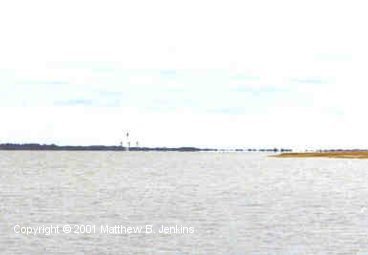
Cape Charles Light
Smith Island, VA - Northern mouth of the Bay
cir. 1895
Cape Charles Lighthouse stands on Smith Island, VA, a wildlife refuge on
the Atlantic Ocean side of the northern mouth of the Bay, that is reachable
only by boat. (This should not be confused with the more well known Smith
Island, MD.) Like the Cape Henry Lights, Cape Charles could be considered
an Atlantic coast light and is sized accordingly.
This is the fourth tower to be built at this location. The
first was a 60 foot white masonry tower commissioned in 1828. That light
proved inadequate and construction on a new, larger tower was begun in 1856.
The new tower was only partially completed in 1862 when it was destroyed
by Confederate raiders. More funds were appropriated and a 150 foot brick
tower was completed under Union guard in 1864. However shore erosion
was severe. In 1889 it was condemned and was finally toppled by a severe storm in 1927.
The current tower was built in 1895 about a mile west of its predecessor.
It consists of an iron column containing steps to the lantern, supported by
an external, octagonal, iron skeleton. During World War II, three cement
observation towers were built close to the light and used to look for German
U-Boats. The light was fully automated in 1963 and the ten foot tall,
one ton, first order Fresnel lens moved to the Mariners Museum in
Newport News, VA. While the lighthouse tower stands in good working order
and continues to be used as an aid to navigation, a fire burned down the
keepers dwellings in the summer of 2000.


Copyright © 2001, Matthew B. Jenkins










